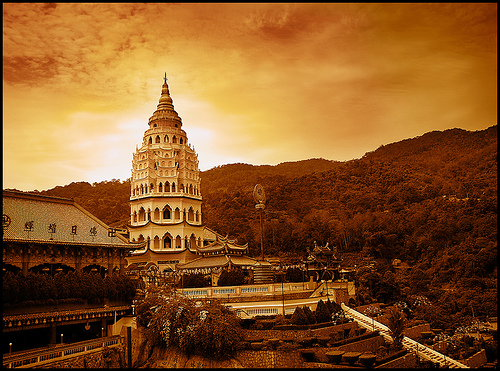The Kek Lok Si Temple (simplified Chinese: 极乐寺; traditional Chinese: 極樂寺; Penang Hokkien for "Temple of Supreme Bliss" or "Temple of Sukhavati") is a Buddhisttemple situated in Air Itam in Penang and is one of the best known temples on the island. It is the largest Buddhist temple in Southeast Asia.
Mahayana Buddhism and traditional Chinese rituals blend into a harmonious whole, both in the temple architecture and artwork as well as in the daily activities of worshipers.

History
The construction of the temple began in 1890 and was inspired by the chief monk of the Goddess of Mercy Temple at Pitt Street. With the support of the consular representative of China in Penang, the project received the sanction of the Emperor Guangxu, who bestowed a tablet and gift of 70,000 volumes of the Imperial Edition of the Buddhist Sutras.
The primary benefactor of the Kek Lok Si Temple in 1906 was none other than Kapitan Chung Keng Quee.
In 1930, the seven storey main pagoda of the temple or the Pagoda of 10,000 Buddhas, was completed. This pagoda combines a Chinese octagonal base with a middle tier of Thai design, and aBurmese crown; reflecting the temple's embrace of both Mahayana and Theravada Buddhism.
In 2002, a 30.2m bronze statue of the Kuan Yin was completed and opened to public. It replaced the previous white plaster Kuan Yin statue which was damaged due to a fire a few years earlier. The bronze statue is located on the hillside above the pagoda while the head of the previous statue which survived the fire is preserved and placed on the right hand corner of the new statue.

Visiting the Temple
Most visitors approach the temple as they ascend a stairway, roofs of which provide shelter to a multitude of shops selling souvenirs and other - mostly secular - commodities. They pass by a so-called Liberation Pond, following the buddhist tradition of merit-making, turtles may be released into freedom, albeit a limited one.
The temple itself consists of several large halls for assembly and prayer, here, statues of Buddha, various Bodhisattvas as well as Chinese gods are being venerated. Intricate woodwork, often brightly painted and a plethora of lanterns add to the visual impression.
There is an inclined lift to carry pilgrims and visitors further uphill. On the elevated platform, you can find a pond filled with Koi and the towering statue of Kuan Yin, Goddess of Mercy, which can also be regarded as Avalokitheshvara, Bodhisattva of Universal Compassion.

reference:
No comments:
Post a Comment